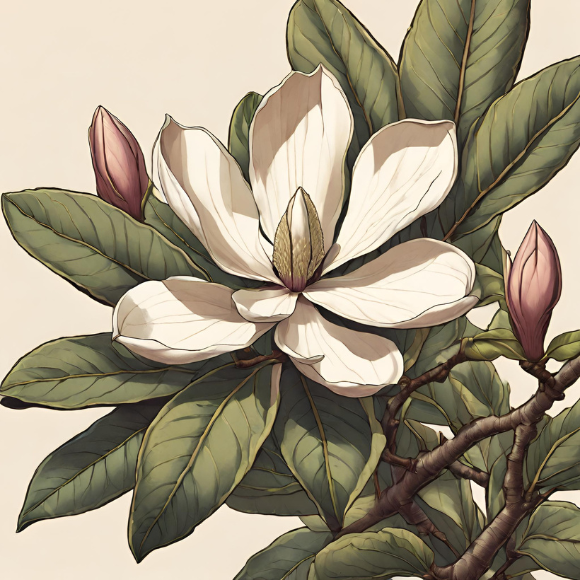
Overview
Southern Magnolia (Magnolia grandiflora) is an iconic and evergreen magnolia species known for its impressive, large, glossy leaves and strikingly fragrant, creamy-white flowers. This magnificent tree is a symbol of the Southern United States, adding timeless beauty to landscapes and gardens. Understanding its specific requirements is key to successfully cultivating and enjoying the splendor of the Southern Magnolia.
Description
Flowers: Fragrant, creamy-white flowers with a diameter of 8 to 12 inches. Each blossom consists of six to 12 waxy petals and exudes a sweet, lemony fragrance.
Foliage: Large, leathery, dark green leaves with a glossy sheen. The leaves are typically 5 to 8 inches long, providing an attractive backdrop for the flowers.
Size: Southern Magnolias can reach impressive heights, often ranging from 60 to 80 feet, with a spread of 30 to 50 feet. However, some cultivars, like Little Gem, are more compact, making them suitable for smaller landscapes.
Soil Requirements: Southern Magnolias prefer slightly acidic to neutral soil with a pH range between 5.0 and 7.0. This adaptable tree can tolerate a variety of soil types, including loamy, sandy, or clay soils. Well-drained soil is crucial for Southern Magnolias. While they can tolerate occasional wet conditions, prolonged waterlogging may lead to root-related issues.
Sun Requirements: Southern Magnolias flourish in full to partial sunlight. While they can tolerate partial shade, providing ample sunlight encourages robust growth, lush foliage, and prolific flowering. Select a planting location that receives at least six hours of direct sunlight daily for optimal performance.
Watering Needs: Establishment Period: Newly planted Southern Magnolias require consistent watering to establish a strong root system. Water deeply, keeping the soil evenly moist during the first growing seasons. Once established, Southern Magnolias exhibit a degree of drought tolerance. However, regular watering during dry periods is advisable to maintain overall health and vigor. Aim for deep watering rather than frequent shallow watering.
Mulching: Applying a layer of organic mulch around the base of the tree helps retain soil moisture, suppress weeds, and regulate soil temperature. Mulching is especially beneficial during the establishment period.
Hardiness Zones: Southern Magnolias thrive in USDA hardiness zones 7 to 9. These zones encompass the southeastern United States, including states like Florida, Georgia, Alabama, Mississippi, Louisiana, and parts of Texas and the Carolinas. The tree is well-adapted to the subtropical and mild climates of these regions.
Maintenance
Pruning: Southern Magnolias generally require minimal pruning. Allow the tree to develop its natural, pyramidal shape. Pruning is primarily done for structural purposes in the early years or to remove dead or damaged branches. The ideal time for pruning is late Winter to early Spring, before the onset of new growth. Avoid heavy pruning in late Spring or Summer, as it may remove potential flower buds.
Fertilization: Southern Magnolias are relatively low-maintenance when it comes to fertilization. However, applying a balanced, slow-release fertilizer in early Spring can provide essential nutrients for healthy growth.
Pest and Disease Management: Southern Magnolias are generally hardy, but monitoring for common pests like scale insects and occasional fungal diseases is advisable. Treatments, if needed, should be applied promptly.
Southern Magnolia, with its regal presence and captivating blooms, is a standout addition to Southern landscapes and beyond. By understanding and fulfilling its specific requirements—ranging from soil conditions to sunlight exposure—you can ensure the health and beauty of this iconic tree. Whether gracing a large estate or enhancing a suburban garden, the Southern Magnolia’s enduring charm makes it a quintessential choice for those seeking a touch of Southern elegance in their outdoor spaces.


 Previous
Previous

